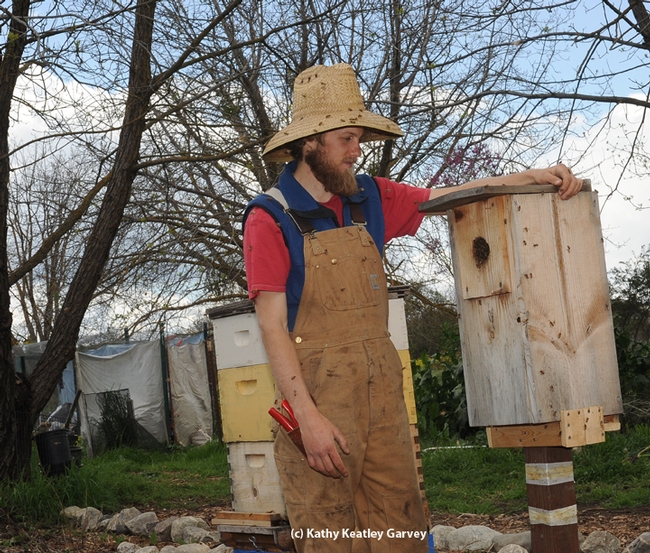
Extension apiculturist Eric Mussen of the UC Davis Department of Entomology and Nematology recognized it right away. He's seen or heard of many a wood duck box taken over by honey bees looking for a suitable home.
It's enough to drive the duck enthusiasts quackers.
The question came up again this week, as it periodically does. Someone asked him: "How do you keep wood duck boxes for their intended purpose?" Mussen's observations are worth repeating.
"Years ago I spent some time with a UC Davis student trying to find ways to dissuade honey bees from nesting in wood duck boxes," Mussen recalled. "They had found one box in which the female duck refused to go, so the bees built their combs right down over and around her, killing her. We tried to prevent the bees from being able to grip the top of the box, where they connect their downward-hanging combs. The Teflon tape that we used prevented them from starting at the top and building down. But, they started on the wall at a corner, build some comb up against the Teflon--yes, beeswax sticks to Teflon--then built the combs down. The stickum on the Teflon tape wasn’t good enough to keep the combs stuck to the top, so the whole thing eventually collapsed in a heap."
"We tried Insectape strips (produced by Rainbow Technology) that were supposed to repel bees and wasps from building in electric boxes. We poured the artificial 'swarms' into the boxes to see if they would be driven out by the pesticide strip. It killed them--they didn’t leave. The strips might repel a real swarm under natural conditions, but that is not how we tested it."
"It would be pretty hard to determine where the swarms originate. Right around swarm time is when many beekeepers are looking for suitable locations to build up their colonies and make 'splits.' The bees need a good supply of food for building up, and beekeepers may be moving their bees close to wood duck nesting areas for the spring nectar and pollens."
One option is placing bee boxes near the wood duck boxes to trap honey bee swarms, "especially of the boxes contain some previously used combs."
"There also is a honey bee attractant--pheromone--that can be purchased from beekeeping supply companies to entice the bees into the trap box," Mussen says. "For whatever reason, the trap hives work best at about nine feet off the ground. Some of the beekeeping supply companies also offer what look like really large flower pots with a cover. They are made of some sort of wood pulp--so they don’t really look like bee boxes. By opening a quarter-sized hole in the narrow end, the pots can be put out as trap hives and work pretty well. Despite your best intentions, however, some of the swarms just ignore the trap hives and go somewhere else. So, some will end up in the duck boxes, anyway."
What to do? Visit the wood duck boxes frequently to remove the bees before they accomplish much. "Unfortunately, once they have built some comb in the box," Mussen says, "the odor makes the box much more attractive to the next swarm."
Another issue: some folks troubled by the declining bee population insist on letting honey bees be. "We have become 'blessed' with an increasing number of individuals who believe that honey bees should be left to their own devices, to do whatever happens," he says.
So, to all those folks wanting to retain wood duck boxes for ducks, Mussen says to engage in periodic monitoring to help out their feathered, webbed buddies. That includes removing the bees.
Mussen didn't say this, but I think he meant that you don't have to get up at the "quack of dawn" to do it.
Attached Images:
